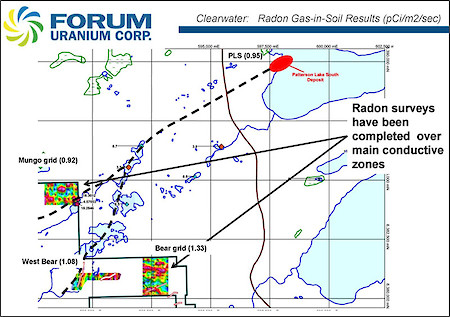

In the Athabasca, mineralization is typically accompanied by a conductor and an alteration halo observed as a resistivity low in the lower sandstone. Further ground geophysics prior to discovery and during delineation consisted of DC (Direct Current) Resistivity and EM surveys. There was also some difficulty correctly spotting drill targets over the complex areas. The initial interpretation of the airborne VTEM encountered complex multiple sub-vertical conductors which were poorly resolved with the in-loop geometry of the VTEM EM system. Feb 2012 – VTEM Conductivity 2011 – 2012 Ground Geophysics Of considerable interest was the conductive ‘bright spot’ in an up-ice direction from the radioactive boulder train along a complex PLS main conductor trend. The conductivity peaks do not appear at the location of sub-vertical conductors but are on the shoulder of the Z component response. The Z component is used for this calculation as it is the stronger and cleaner response. The conductivity is based on the VTEM decay of the Z (vertical) component. The calculated conductivity was used as an initial indicator in defining priority drill targets. Some of the MaxMin profiles encountered a ‘conductive overburden’ response masking bedrock features, so a property-wide VTEM™ (Versatile Time Domain Electromagnetic) survey was conducted in 2012 and successfully outlined numerous conductors throughout the property. Initial surveys were MaxMin Horizontal Loop. The survey was carried out by Special Projects Inc., of Calgary, AB. A low level tight drape flight pattern at 50 m line spacings was used for extremely detailed coverage. Some innovative proprietary focussed crystal arrays were used on a small fixed wing aircraft. The 2009 airborne radiometric survey was instrumental in locating the boulder field. Quaternary Snapshot Window of Opportunity 2009-2012 Airborne GeophysicsĪirborne geophysics consisted of an initial property wide radiometric and magnetic survey. Discovery Hole PLS12-22 Massive Pitchblende Figure 5. Airborne and ground geophysical surveys identified a number of prospective target areas, and drill testing resulted in the massive pitchblende discovery in November 2012 (Figures 3 and 4). The conceptual section was invaluable in planning further work and selecting targets.

Follow-up prospecting and trenching with Quaternary geological analysis developed a conceptual section for potential mineralization (Figure 5). A subsequent airborne radiometric and magnetic survey was instrumental in focussing ground prospecting for radioactive boulders. A review of historical assessment reports (late 1970s) showed strong radon anomalies coincident with EM conductors 3 to 4 km west of the deposit. The initial phase of work leading to the discovery consisted of research. The Millennium and Roughrider deposits showed the basement is not to be ignored. Exploring outside of the basin margins is somewhat unconventional as there is no present unconformity surface, but there may have been in geological history. Cluff Lake is an anomalous occurrence and is located on the Carswell Dome, not within the Athabasca Basin. The east side of the Athabasca Basin hosts virtually all the major high grade deposits with the exception of Cluff Lake and the deep Shea Creek deposits and now the new deposits in the Patterson Lake Corridor. The sandstone environment is normally highly resistive which makes things ideal for EM detection of weaker graphitic conductors at depth. The Athabasca Basin major uranium deposits and mines (Figure 2) are generally proximal to graphitic conductors (reducing environment) and accompanied by an alteration ‘halo’ which is usually a resistive low, but can also be silicified (resistivity high). The PLS discovery has been previously documented and some content is borrowed from these presentations: 2012 Saskatoon Geological Open House, 2013 Saskatoon Geological Open House and the Fission Web Site. Patterson Lake South (PLS) and Canada’s Athabasca Basin Fission has 100% ownership of the PLS Property, which comprises 17 claims totaling 31,039 ha. Growth is driven by a highly skilled, award-winning technical team and successful entrepreneurial management. It is the only major, high-grade deposit in the region that is potentially open-pittable and is the largest mineralized trend in the region – currently standing at over 3 km in length. The deposit is accessible by all-weather Highway 955 which continues north to the UEX-AREVA Shea Creek deposit and former AREVA Cluff Lake uranium mine (Figure 1). The Triple R deposit on Fission Uranium Corporation’s Patterson Lake South (PLS) property is located in Canada’s Athabasca Basin, home to the world’s richest uranium mines.


 0 kommentar(er)
0 kommentar(er)
